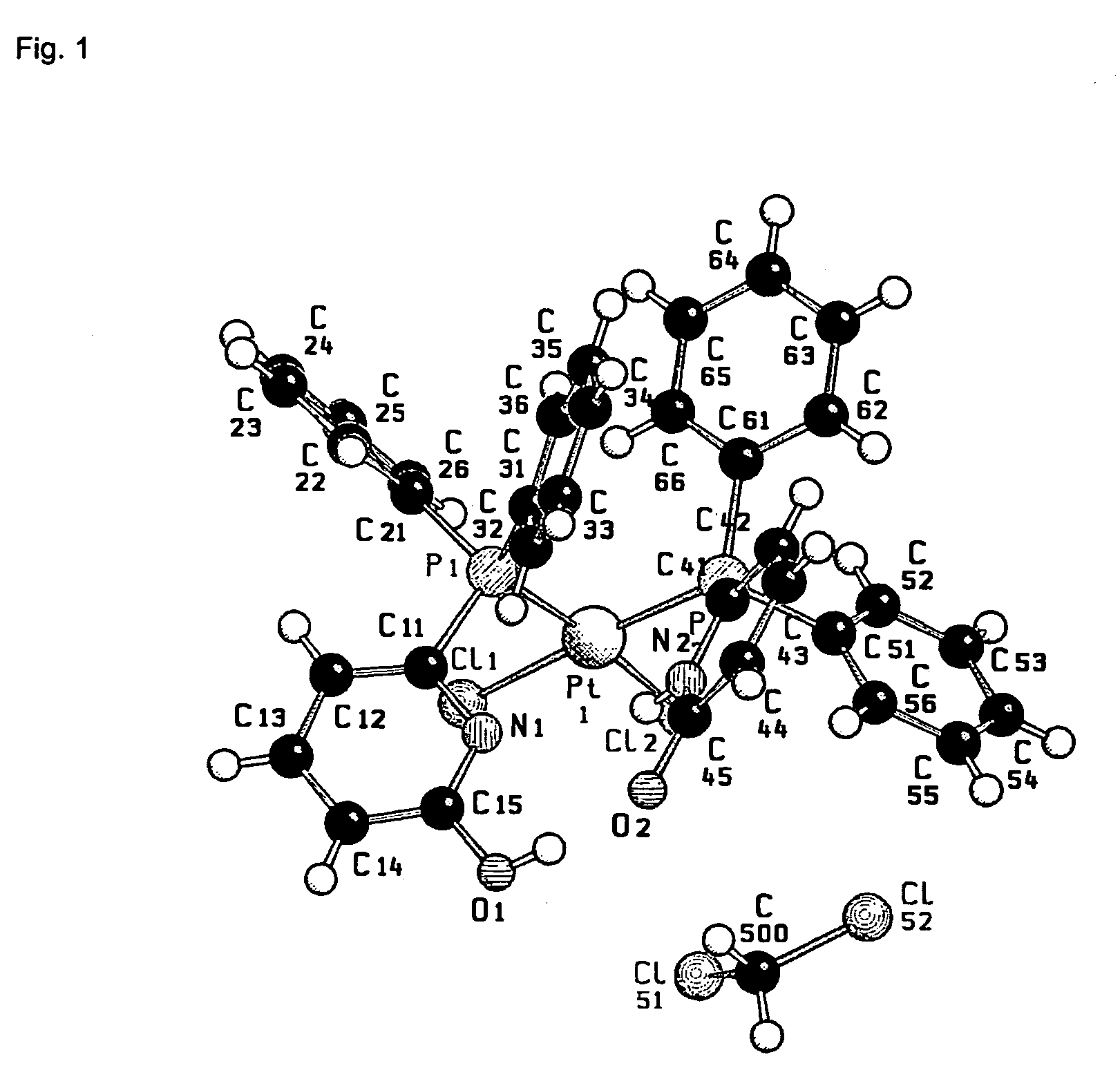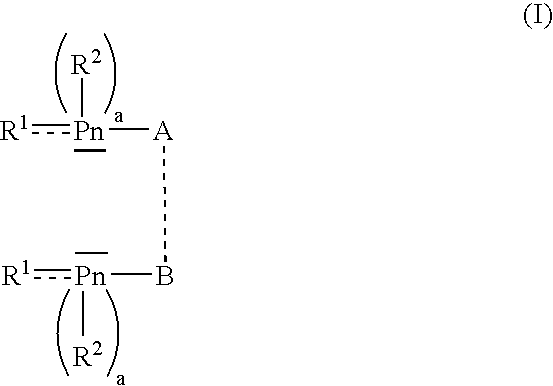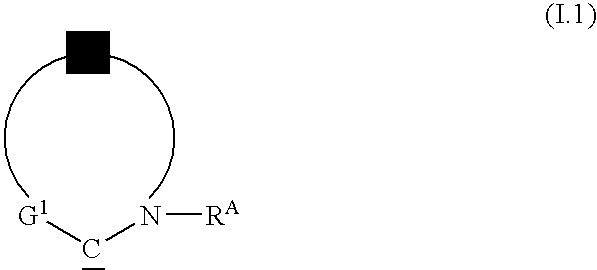Method for asymmetric synthesis
a technology of asymmetric synthesis and synthesis method, which is applied in the direction of organic compound/hydride/coordination complex catalyst, organic compound/chemical process catalyst, group 5/15 element organic compound, etc., can solve the problem of not teaching the use of ligands having a functional group, complex syntheses are frequently required for their preparation, and obtain only in poor yields. , to achieve the effect of high stereoselectivity, high yield and high stereoselectivity
- Summary
- Abstract
- Description
- Claims
- Application Information
AI Technical Summary
Benefits of technology
Problems solved by technology
Method used
Image
Examples
example 1
Preparation of 6-(1-naphthylphenylphosphino)-2-pivaloylaminopyridine (6-NPPAP)
[0267]
[0268]n-Butyllithium (8.7 ml, 14.0 mmol, 1.6 M solution in hexane, 2 eq) was added to a solution of 2-bromo-6-N-pivaloylaminopyridine (1.80 g, 7.0 mmol) in tetrahydrofuran (30 ml) at −100° C. over a period of 20 minutes and the reaction solution was stirred at this temperature for 1 hour. After addition of chloro(1-naphthyl)phenylphosphine (1.89 g, 7.0 mmol, 1 eq, prepared as described by G. Wittig et al., in Justus Liebig Ann. Chem. 1971, 17-26), the reaction solution was warmed to room temperature over a period of 12 hours. The reaction was stopped by addition of saturated NaHCO3 solution (30 ml), the, aqueous phase was separated off and extracted with ethyl acetate (3×20 ml). The combined organic phases were dried over MgSO4 and the solvent was removed on a rotary evaporator. The crude product was purified by column chromatography using silica gel as stationary phase and a cyclohexane / ethyl acetat...
example 2
Preparation of a Heterodimeric Pt Complex
[0276]
[0277]A solution of 3-diphenylphosphino-2H-isoquinolin-1-one (3-DPICone) (12.6 mg, 3.82×10−2 mmol, 1 eq) and 6-NPPAP from example 1 (14.4 mg, 3.28×102 mmol, 1 eq) in CDCl3 (0.4 ml) was added to a solution of PtCl2(1,5-cyclooctadiene) (14.3 mg, 3.82×10−2 mmol, 1 eq) in CDCl3 (0.4 ml). The formation of the heteroleptic complex was observed by means of low-temperature NMR spectroscopy.
[0278]31P-NMR 294K (121.468 MHz, CDCl3): δ=6.36 (bd, 1JPt-P=3521 Hz), 8.02 (bd, 1JPt-P=3756 Hz).
[0279]1H-NMR 240K (499.873 MHz, CDCl3): δ=1.11 (s, 9H, CH3), 6.69-6.74 (m, 2H, Ar—H), 6.88 (t, J=7.2 Hz, 1H, Ar—H), 7.17-7.27 (m, 7H, Ar—H), 7.34-7.48 (m, 5H, Ar—H), 7.55-7.72 (m, 6H, Ar—H), 7.79 (d, J=8.0 Hz, 1 H), 7.81 (d, J=7.9 Hz, 1H), 7.87-7.89 (br, 1H, Ar—H), 7.98 (d, J=7.7 Hz, 1H), 8.04-8.08 (m, 3H, Ar—H), 8.24 (t, J=8.4 Hz, 2H, Ar—H), 10.44 (s, 1H, NH), 11.53 (d, J=5.8 Hz, NH).
[0280]31P-NMR 240K (121.468 MHz, CDCl3,): δ=6.36 (dd, 1JPt-P=3515 Hz, 2JP-P=13.2 ...
example 3
Asymmetric hydrogenation of methyl 2-acetamidoacrylate
[0281]
[0282]A mixture of [Rh(COD)2]BF4 (2 mg, 5.0×10−3 mmol, 1.0 mol %), 3-DPICone (2.1 mg, 6.4×10−3 mmol, 1.3 mol %) and (+)-6-NPPAP from example 1 (2.7 mg, 6.5×10−3 mmol, 1.3 mol %) was dissolved in dry and degassed CH2Cl2 (5 ml) and stirred at room temperature for 10 minutes. The catalyst solution was admixed with methyl 2-acetamidoacrylate (71.6 mg, 0.5 mmol) and the solution was transferred to a steel autoclave. The autoclave was flushed five times with hydrogen and subsequently brought to a pressure of 5 bar at room temperature for 48 hours.
[0283]After the reaction was complete, the conversion was determined by means of 1H-NMR spectroscopy and the enantiomeric excess was determined by means of chiral GC (Hydrodex β-TBDAc).
[0284]The conversion was quantitative, and the enantiomeric excess was 43% (R).
PUM
| Property | Measurement | Unit |
|---|---|---|
| enantiomeric excess | aaaaa | aaaaa |
| enantiomeric excess | aaaaa | aaaaa |
| enantiomeric excess | aaaaa | aaaaa |
Abstract
Description
Claims
Application Information
 Login to View More
Login to View More - R&D
- Intellectual Property
- Life Sciences
- Materials
- Tech Scout
- Unparalleled Data Quality
- Higher Quality Content
- 60% Fewer Hallucinations
Browse by: Latest US Patents, China's latest patents, Technical Efficacy Thesaurus, Application Domain, Technology Topic, Popular Technical Reports.
© 2025 PatSnap. All rights reserved.Legal|Privacy policy|Modern Slavery Act Transparency Statement|Sitemap|About US| Contact US: help@patsnap.com



